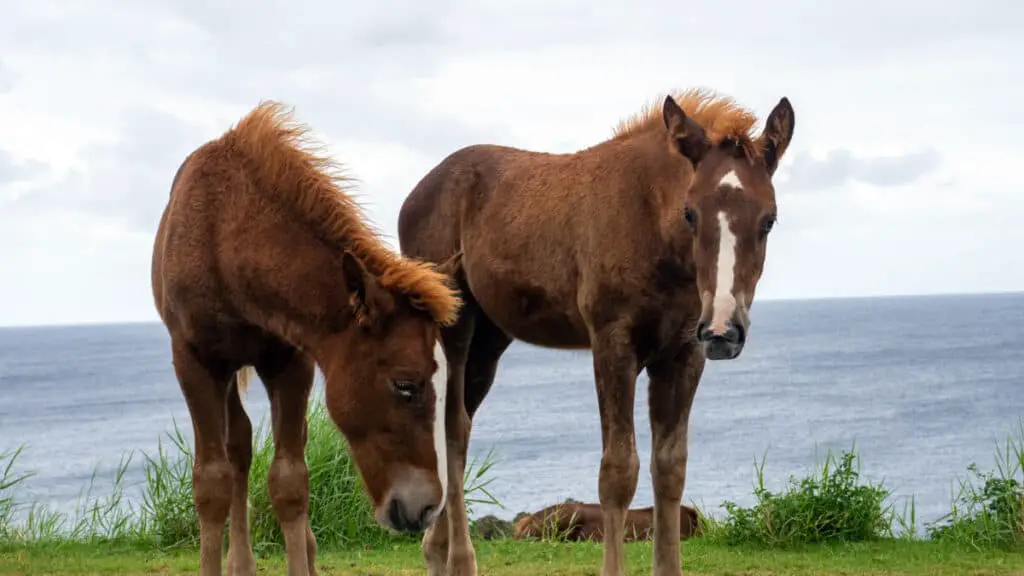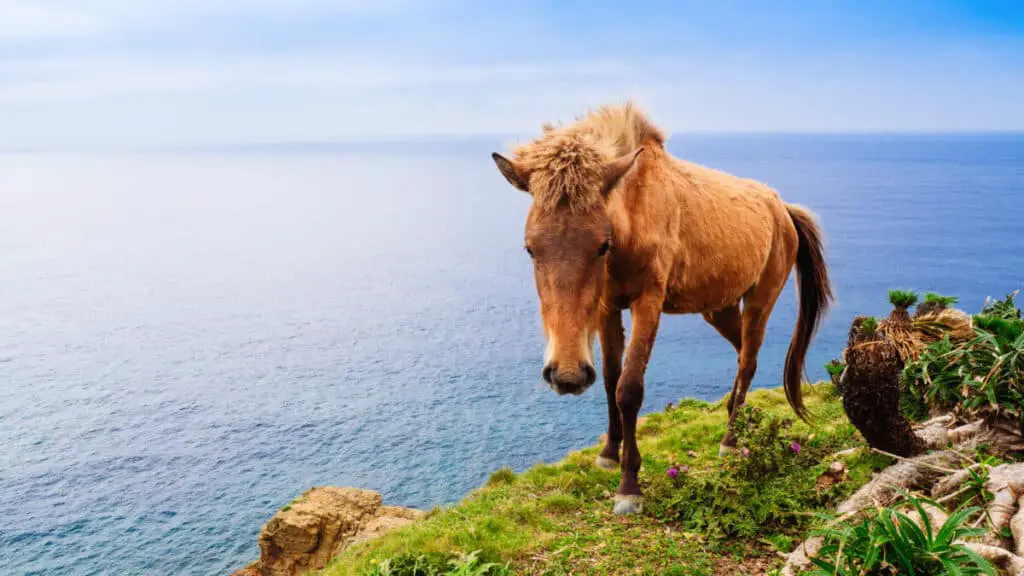Skip To Section
If you travel to the Yaeyama Islands of Japan and stop by the Island of Yonaguni, one of the westernmost points, you may be in for the treat of a lifetime beyond the scenic views.
Yonaguni island is known for being home to the Yonaguni horse or Yonaguni Uma. If you stay for long enough, you will see these strong, small horses roaming the shores of the island or walking through the turquoise waters with children on their backs.

However, these unique Yonaguni ponies are classified as “precious cultural assets” amongst the Japanese population as, since industrialization, their numbers have dropped dramatically. In fact, in 2020, there were just 130 Yonaguni ponies accounted for on the island and in Japan, overall.
As they are 1 of just 8 horse breeds native to Japan and are thus, incredibly important creatures for the country in terms of their rich history and contribution to the deep culture.
History
There are two common tales for how the Yonagunis came to be though neither has been confirmed as of yet and perhaps never will be.
One legend believes the local breed to have been brought from the Korean Peninsula of Cheju in ancient times. While the other claims that they hailed from the southern islands over 2000 years ago. Their origin remains a mystery.
Eventually, however, they became commonplace in Japanese households and played an integral role in carrying items and therefore, assisting with farm labor.
Though, as machine use proliferated with industrialization in the twentieth century, the Yonaguni horse was bred less and less frequently as the need for them fell.
During this time, many horses that were once bred to be workhorses on farms began to be bred as war horses instead. But because of the Yonaguni breed’s small size, they were left out of this trade. The Yonaguni numbers dropped even further until they were almost lost entirely.
Now, they are protected by conservationists and left to roam the island. Thus, their population remains small, but it is no longer decreasing.
Characteristics
The breed is known for its gentle and pleasant nature. They are content sitting on the beach or carrying travelers on their backs. They do not startle easily and remain calm at most times.
These ponies are strong and were thus, used to carry food and supplies in ancient times. Though they no longer serve such purposes, they remain muscular and sturdy horses.
Diet
The breed native to Yonaguni island eats as most other horses do. Their diet mainly consists of grass, hay, and other grains found on the island. They have no notable health concerns.
Breeding And Uses
Their endangered status means they are left to roam freely on their island. The breed does not work for humans at all.
Their days of carrying heavy goods for humans to use on farms are over as their population is protected in every way possible including by avoiding over-exertion.
The Yonaguni Pony Society of the Island of Yonaguni that protects them does breed them in hopes of growing the population further though this is done humanely with little force.
The society also allows and even encourages people to ride them around the island. The breed’s pleasant nature makes them easy to ride for passengers of all ages and experience levels.
The harmony between humans and horses on the island of Yonaguni is remarkable as there are only 130 Yonaguni horses and just 2000 human residents on the island.
Size
Yonaguni horses have a height at the withers of just 110 – 120 centimeters which classifies them as ponies. The height separating a pony from and a horse is about 145 centimeters.
The breed’s average pony usually weighs around 200 kilos.
Colors
You will find Yonagunis in various colors and usually, they are solid as opposed to a mix of many. Most commonly, these ponies are bay, tan, brown, cremello, or roan.
What Do They Look Like?

The breed is small however, they are noticeably strong and very muscular.
They are usually solid colors, and their coats are naturally shiny. They generally have large heads and short necks.
They also have the unique ability to splay all four legs beneath them. So, you may see them laying in this position along the Island’s beautiful beaches as they tend to do.
What Are They Used For?
These ponies were once used as farming aids to carry supplies to and from the island. This was an integral role in ancient times.
Now, however, they are left to roam freely. They are occasionally ridden by visitors to the southern islands as a way of increasing their engagement with humans and vice versa.
Where Do They Live?
The Yonaguni ponies are only known to be living on the island of Yonaguni in the Yaeyama Islands of Japan.
How Much Do They Cost?
As there are only 130 Yonaguni ponies known to exist on the island currently, the breed is protected and considered extremely rare.
Thus, we cannot estimate their cost as they are likely deemed priceless as cultural treasures of Japan.
Are They Good For Beginners?
Yes, Yonaguni horses are extremely gentle in nature. They are calm and patient and perfect for riders just starting out. They do not startle easily or run off when being ridden by inexperienced riders.
Plus, their small size makes riding easier for beginners and children who may be frightened by the height of taller horses.
Conclusion / Summary
The Yonaguni pony is a particularly interesting breed because of its ancient history, its remote and scenic location, and its extreme rareness.
These ponies bring beautiful life and rich history to their island and in turn, the people of the island protect them from any further decrease in their population.
If you ever visit the Island of Yonaguni, you may be lucky enough to see these strong creatures splayed about on the beach, or perhaps taking a traveler on a ride in the clear blue waters. They are a sight to be seen and a breed to be cherished.
There’s a whole world of horse breeds out there to explore! Discover and find out more information by checking out our horse breed guides.
